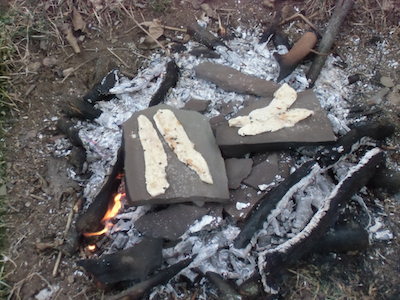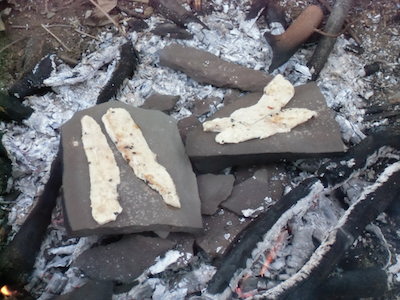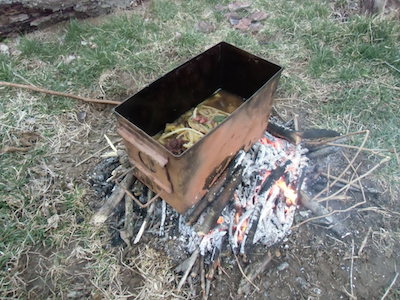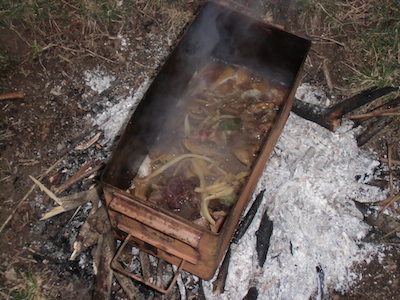Michael Z. Williamson
My upcoming novel, A Long Time Until Now, visits the far past rather than the far future.
A military convoy is interrupted by temporal chaos, and once it's over, ten soldiers find themselves...elsewhere. Eventually, they find enough clues to place themselves in the distant past, with only hints as to exactly when. They have their personal gear, the contents of two MRAP convoy vehicles, and their wits.
While the market for action adventure is bigger than for hard SF, I've always been a fan of the science-oriented story. The limitations of reality, combined with speculations within them, is a rewarding challenge.
Of course, I didn't realize when I started writing A Long Time Until Now that there hasn't been much research about Paleolithic Central Asia. I also had an almost impossible time finding knowledgeable people to talk to. In fact, even with introductions from friends in other sciences, I didn't hear back at all from most of the scholars I was referred to.
I sought professional papers on the subject. They're sparse. Still, I read what there was, and quite a bit on other parts of Eurasia. I found one academic in the field who'd respond to my requests for help; Michael Williams (no relation) of the UK was helpful with some other sources and papers. His site is http://www.prehistoricshamanism.com/. My friends Jessica Schlenker (biologist) and Dale Josephs (research librarian) found a few more. Ross Martinek (petrologist) had some information on terrain and climate. I gathered what I could from all these.
I may have read most of the scholarly papers on that location and era, which tells you how few there are. Other parts of the world have been studied extensively. Large chunks of Asia are still wilderness, as far as prehistoric study goes.
So then I had to fake it, which frustrated and concerned me. This is supposed to be hard science fiction, not fantasy. Then I realized that if we don't know what happened at given times and places, I can't be expected to be exact. So I did the best I could based on the nearest cultures and environments to that timeframe and location.
Next, I started experimenting. I learned or refreshed quite a few skills while writing this. I made fire by friction with a firebow and fire plow. I tried several types of bugs, and prefer them cooked. Emily Baehr brought a bag of weeds (that's plural, okay?) and showed me how to find an entire salad's worth of greens in temperate biomes, even in residential lawns. I used primitive weapons to bag a few targets. I use bows regularly, and have thrown spears. I tried atl-atls and slings. I knapped some bottle glass.
Then I developed several recipes that will appear in my next collection of stories and articles. How do you cook a tasty meal with minimal spices and no cooking utensils? Well, it turns out you can create quite a few spices and seasonings from plants in the carrot family.
There are a lot of edible plants and quite a few spices in the Apiaceae family. In fact, almost all edible plants come from about six families, and do so in the last 7000 years or so. Before that, there's some evidence of rice and wheat, and occasional possible evidence of fruit domestication (versus actual agriculture).
However, it's obvious from the evidence that vegetarianism is just a modern ideal. No matter how many believers bleat about it being "natural," it not only wasn't natural then, it was a complete myth. There just aren't plants in the temperate or boreal latitudes that you can gather for enough protein, fat and calories to stay alive. Even if you could, you won't find them in December. This is a world nothing like our own. No domesticated grains, no herded animals. Even modern "wild" berries are usually contaminated, and sweeter, because of cross-pollination with domestic breeds. I've had vegetarians insist we were mostly vegetarian at the time, but they're unable to name the plant species we allegedly derived our calories from, especially fat. I'll save you time: There are almost none. Gathering non-fruit comestibles is a net calorie loss and a waste of time.
Most of the Paleo diet people won't be happy either. There was a lot of meat, but most of it was stringy and lean. Humans need fat for brain development and to maintain the skin, among other organs. When you can't get gorged, winter-ready animals with a layer of fat to eat, you wind up eating brains, livers and kidneys. They also provide salt, minerals and flavor. Hunter gatherers cherish the organ meats for nutrition. You'll want a lot of fatty fish, too.
After a week of this diet, I was ready to kill someone for some french fries or a peanut butter sandwich.
Food preparation is another matter. Rocks work well for cooking, as do sticks, and of course, a military convoy has ammo cans, but are the painted surfaces non-toxic even when scoured? More research.
Ten people can't live for long in the backs of two trucks. If they don't want to be adopted into a Paleolithic village, they need shelter. Since few animals and no predators really fear humans in an environment like that, it needs to be protective shelter. Then, how much can you trust your neighbors?
But, how much can you do with ten people, when you need watch standers and hunters? With hand tools only, and damned few?
A teepee is easy, and variations on it or the wickiup are universal. There are actually quite sophisticated building foundations going back 30,000 years, of rocks dug and set to make a solid lintel on which to place struts and poles for any number of lodges. You cover them with sheets of bark, or with hides that you then smoke to shrink and preserve. Then there's a way to produce leather that might have been found by accident. I put that in there.
But a palisade is a useful thing, though a lot more labor intensive. It blocks vision from the outside, wind, animals, foes, and provides a lot of comfort and safety. All you need is a thousand logs...
...and then a few more for log cabins.
So where do you put your midden heap and latrine? How do you reach the stream and the well?
All these issues pile atop each other. You have to eat, stay warm, stay sheltered, get clean, plan ahead.
This led to the next problem: Sheer volume.
There's only so much room in a book, and it has to be story, not background, but that background is an essential part of the conflict in a story like this. Man against the environment is one of the classic literary struggles. There's more I could have put in, but I had to leave some areas unfulfilled. I was at 212,000 words.
For example, the troops have melee weapons aboard the vehicles on convoy, against potential boarders. Being American troops, I guarantee someone will have a glove and ball to go with the bats. But there is no Stone Age ball game, because I couldn't find anywhere to place one. I didn't go much into the care and feeding of penned goats.
There have been some initial reviews from people who wanted more action, and missed the lack of a named villain. But nature herself can be the ultimate opposition, especially when resources are short. Nor could I find anywhere to insert epic battles between time travelers or Paleo natives. However, there's plenty of possibilities for those in a sequel.
Of course, realism only goes so far. I learned that long ago, during a Dungeons and Dragons campaign where the Dungeonmaster insisted on excess realism. We each rolled six sets of three dice for our attributes and played from there. The results weren't impressive. Normal people don't adventure. If they try, they die.
Military members at least have basic standards of fitness and training that are above normal, which is disturbing to think about--half the population are below average, and I've commented sarcastically that I think that's being generous. Especially when it comes to any training outside of the narrow scope of a person's culture and society.
But, that military training is specific, and the standards can vary by circumstance. I didn't cheat, but I did optimize some of the characters' backgrounds and gear. You will find people in the military with all of the skillsets and training mentioned within. You won't necessarily find them all in one location, but it's not impossible. You will find all the described equipment, and more, on trucks in war zones. Troops take what they think they need for engagement or comfort.
Even with that, the characters have only what they had with them when it happened. I gave them a little help. They have proper pioneer tools, not the multiple headed "Max" monstrosity that is issued. There's a decent tool kit aboard one vehicle. They have plenty of knives. They have some rechargeable batteries and two chargers. The rest of the gadgets will die as their batteries do. Lighters only last so long, and of course, caffeine and tobacco will run out in days. A good axe and spade can be worth their weight in salt when you cannot replace them, and salt can be almost priceless. All these things do occur in theater, and I gave them just enough to make them miss the rest. Hearken back to that role playing game. If regular people go adventuring in street clothes, the story is boring, because they die.
The troops, however, can't approach things with a combat mindset, because their ammunition is finite, and megafauna are not impressed by 5.56mm. If you are lucky, the wooly rhino won't even notice the attack. If you're not lucky...
I liked the characters, even the ones I didn't like. I knew where I wanted them to go. I knew their feelings and motivations. They were consistent, and they were human.
They're a mixed bag. They're not all Soldiers--two are borrowed from other branches, known as ILOs in some documents--In Lieu Of. Only one is Combat Arms, the rest are various flavors of support. Two are women. Two aren't in great shape, because they're older and broken, and panicking over what will happen when their medication runs out. Stay in the military long enough, you'll get broken, too. They are urban or rural and technical or intellectual. There's not really a "typical" service member, with a nation of a third of a billion to recruit from, and several territories and protectorates. That's what a unit looks like these days. That required research, too, since I'm an immigrant myself and don't really know what any "typical" American is like at an intimate level.
Some are religious, and while I'm agnostic myself, I was raised Anglican. There would be serious matters of faith for a believer in these circumstances. They have different politics, which are of no immediate matter, but color their perceptions. I always hated cookie-cutter military characters, and I try not to write them. Those I served with were of a broad spectrum.
Then, what's it like being the minority group in the world? What's it like when you're the minority among that minority? The closest I came was deploying with an element that was about half and half Puerto Ricans and Guamanians. The rest were mostly Mormons. I was not only the token Mid-Westerner, I'm an immigrant one at that. Even if people are supportive, it's lonely. When there's no one else in the world like you, it's going to have a deep emotional bite.
I knew the plot, the story, the challenges. I even had most of the technical gear in mind. I know what people can do with limited resources when they have to, and how they adapt tools to fit their needs.
These characters are Soldiers, though, not scientists. They know some of what they need, they can learn the rest, but some of it they can never know.
So there are mistakes of fact in this book. They're not a problem; they're by design and intent.
There are two types of errors in this book. Errors of knowledge, and errors of memory.
The characters are suddenly about 15,000 years in the past. One of them has enough knowledge of astronomy, and others some training in archeology and climate, to make that estimate. I know the exact date, and even what the stars look like at night (thank you, stellarium.org). I may tell you in a future book.
But they don't know a lot of other things. None of them know ceramics, for example. Molding clay is easy, but how do you fire it? What do you use for glaze? Possibly some combination of sand, ash and salt? They don't know, so in this story, they don't try. If they have long enough, they might experiment.
There are skills they just don't have, and there's no internet to research it even at a cursory level. They have to guess about some aspects of the Romans and their culture. They have to develop some skills from pure theory or hazy memories. Their ongoing frustration shows. The internet may be the greatest information tool humanity has ever developed, and most people use it to post pictures of kittens and scream, "Fuck you!" at each other. You don't miss what you take for granted until it's gone. They have laptops, and access to all the critical military software such as porn and Powerpoint, but no way to retrieve any other data.
I deliberately didn't research any areas the characters didn't know, and wrote about those from my memory (or from the characters' memories, based on deliberately incomplete notes). Two of them know about the Younger Dryas and the 8.2 Kiloyear event, but is that 8.2 Kya or 8.2K BCE? And how much are they before or between those events? If you know in theory how to extract iron ore, do you recall how to make a reduction furnace? How do you feed air to it? If you know edible plants in the modern US, how much do those resemble Paleolithic Central Asia? Which nuts are edible before agriculture, and which have toxins? How do you use an animal's intestines to make sausage casings or rope? Regarding the armor and clothing various people wear, without direct discussion, and a common dateline, it's hard to guess their exact age. The Romans know who their emperor is. The Americans don't recall his reign dates.
As far as interacting with the displaced Romans, I had an expert translate the actual Latin. The Americans fudge their Latin from English words which I reLatinized from memory (and I'm sure for inventing that word, some swastika-wearing grammarian is going to chase me down and hurl books at me). It's a butchered lingua franca, but comprehensible.
So names, dates, technologies and skills are sometimes wrong, because the characters would have them wrong. Nor would they have any way to ever check. If you find those errors, they're there because I meant them to be, and did not allow any corrections in the copy-edit process. The characters can't know all these things, so they don't know them. Still, if you want to talk to me about those areas, it might make for a great conversation. I prefer red ales and single malts, just in case you need to know.
The story is about people, stuck in a world that's partially familiar and sound, and largely alien and terrifying. You probably don't know how dark it is, under an overcast sky, when there are no cities. These days, the glow can be visible for hundreds of miles. With nothing but a small fire, a cloudy night is literally as black as a darkroom. Then the trees creak, and something predatory makes noises...
As to the science, I'm sure the little research done in that real world location will be expanded upon in the coming generation, and our overall knowledge of the era will change and improve dramatically.
Consider that "The Quest for Fire" was hard SF when it was written in 1911. I wonder how my novel will hold up in a century. I can only hope the character story survives better than the science story will.
The story is available in eARC now, and will be available in hardcover, electronic and audio formats starting on 5 May.
In the meantime, here's two recipes to get you in the mood:
Stone Age Chicken:
You will need a pizza stone. If not, you'll need slate or granite paving stone, but heat it very slowly to make sure the moisture is out before cooking. Fast heating can cause…explosions. If you have nothing like this, you can use a cast iron pan, dry.
Salt (colored rock salt preferred)
Wild onion (You can probably find it in your lawn, if you haven't sprayed everything dead with pesticide. Otherwise, go to the park and find some. It's endemic.)
Greens from wild carrot or something in its family, but be careful with Queen Anne's Lace.
Black sesame seed (sparingly)
Build a fire and let it burn down to coals against your rock.
Crush the salt against a rock with your knife blade. Repeat with the sesame. Catch in a canteen cup, ammo can lid or clean leather.
Crush and shred the greens and wild onion. Mix with the salt and sesame in a clean ammo can lid or on a flat stone.
Slice the chicken into thin strips. Peel pieces off the bones. Drag them through the herb and spice mix.
Let them age while the stone heats. Rake the coals around the rock and let it heat (keeping in mind the safety warning above). You can also do this on a good charcoal grill if you are an apartment dweller, using real hardwood charcoal, not those plastic-bindered "briquets".*
Once it's had a half hour in the fire coals, lay the strips on the stone. They'll sizzle and steam and if you cut them thin enough, will cook in a matter of seconds. You want the outside golden brown.
My teenagers swear by this and I have to make it every week or so. If you have a little fat, suet or seed oil, you can follow up with shelf fungus (you'll need to research how to ID and ensure it's safe. It's easy, but I take no responsibility for what you acquire), sautéed until crisp and brown.
Now, try it. I think you'll agree, that does not suck.
By the way, I had Jane Sibley, PhD, make up a batch of a similar spice combination for ongoing use. If you're interested, contact her at http://www.auntiearwenspices.com/index.html and ask for Crazy Einar's spice mix.
*(NOTE: Try the hardwood lump charcoal. Most hardware stores and good groceries have it. The bag weighs less, but contains about the same heat value for cooking, burns a lot cleaner with less ash, and makes the food taste much better. Tried it? You're welcome.)
Field Pot Roast Stew
Required: Carved or turned wooden bowls treated with butternut or walnut oil.
Ammo can or other deep metal pan.
Your cooking rock and fire.
Take a joint or a chunk of beef or antelope roast, rub all over lightly with salt and let rest for a couple of hours. Keep the flies away using a tepee of sticks and a shirt.
Brown on all sides on your hot rock.
Place in a roasting pot. A clean, seasoned ammo can will work if you have no roasting pot. Scour the paint off the inside with sandstone, using a stick and sand in the corners, [or by] heating, then dousing remaining paint with water. Season with nut oil or animal fat over a low fire.
Take several wild onions, chop off the roots, rinse off the dirt, and chop into chunks. Smash the root bulbs against a rock with your knife. Place in pot. Add another sprinkle of salt.
Add several rinsed root bulbs of dandelion or carrot-family roots, small and fresh. As they age, they'll go tough and woody.
Finely chop some pine needles or scrape out some pine nuts. Add a little more salt. Add about a half inch of water.
Simmer over or next to a bed of coals for two hours. Add water as needed to maintain level.
Chop, slice or shred beef into chunks.
Chop up several small apples and add as a starch and thickener. Cook another 30 minutes.
Serve in bowls.


Chicken strips on a hot rock.
Notice the shattered slate. Moisture in the rock causes this when heated. Any water bearing rock must be preheated while you stand well clear, but I recommend not using slate, shale or similar stone. Granite is much better, if you can find flat pieces.
The chicken cooks quickly, and can be peeled up with a knife and eaten directly. The black specks are sesame seed.


The stew in the ammo can. Shelf fungus was added as well as the ingredients above.
The ammo can works for baking, pot roasting, or stewing. It's also a good idea to season the outside with meat drippings periodically. Since it's sheet metal, it won't take as much heat as cast iron. Don't overheat it.
Copyright © 2015 Michael Z. Williamson
Michael Z. Williamson, a retired member of the US military, is the author of the best-selling Freehold series of military science fiction novels. Williamson has also authored books such as Tour of Duty and The Hero, written in collaboration with author John Ringo. His latest work, A Long Time Until Now, is the first in a new series that is out in May 2015.

